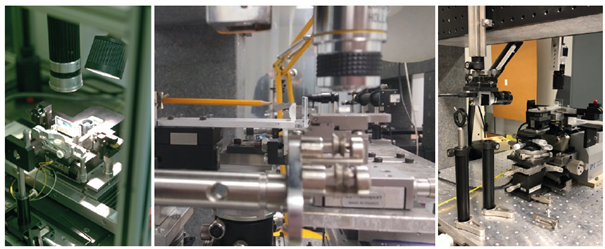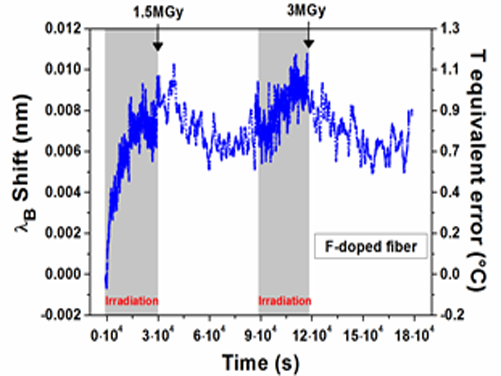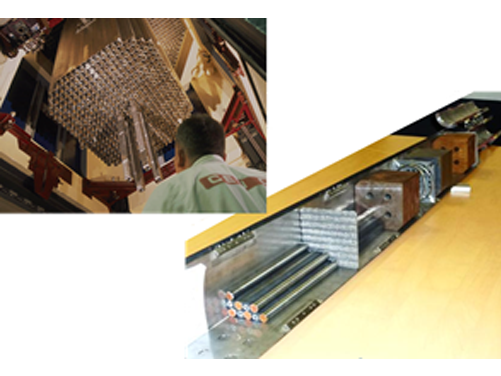LabH6: Fiber Bragg Grating for sensors in harsh environment
Optical Fiber Bragg Gratings (FBGs)
POINT SENSORS FOR TEMPERATURE AND STRAIN
Fiber Bragg gratings (FBG) are the most widely deployed optical fiber sensors in the various nuclear environments, mainly for local (point) temperature or strain measurements.
The Bragg wavelength shift dependence on these parameters is a smart and efficient solution for their monitoring. Indeed, its measurement makes it possible to follow in real time their evolutions. Radiation impacts the response of FBGs via two main mechanisms [A. Gusarov et al., IEEE TNS, 2013]: the first is related to a possible erasure of the grating and therefore to a total loss of the sensing point. Techniques are now mastered to avoid it. The second, more problematic, consists of an irradiation-induced shift of the Bragg wavelength, which causes an error in the temperature or strain measurements.
Numerous studies have been conducted in collaboration with AREVA (now ORANO) and the CEA to understand the physical mechanisms governing the responses of the different categories of FBGs [A. Morana, PhD thesis, 2013] that can be performed thanks to the LabHC and iXblue facilities (Fig.1). Their fine understanding has made it possible to define a FBG manufacturing recipe via the LabHC femtosecond platform with a very limited shift in the Bragg wavelength even at high radiation doses [A. Morana et al., Optics Lett., 2014]. These results initiated the European project HOBAN on this technology (see box) leading to the maturation of this technological breakthrough.

| HOBAN PROJECT
LabH6 participated in the European project HOBAN funded by Kic InnoEnergy This project, coordinated by AREVA, in collaboration with the Fraunhofer Institute (Ge), SmartFibres Ltd (UK) aimed to develop a temperature sensor that can operate at high doses of radiation (several MGy) and at high temperatures (up to 300°C). A prototype sensor has been qualified, integrating FBGs inscribed by the LabHC via a femtosecond laser into a single-mode radiation-hardened fiber developed by iXblue [A. Morana et al., IEEE TNS, 2017]. The prototype meets the targeted specifications (1 MGy, 300°C) with a measurement accuracy of 1°C, thanks to the implemented hardening techniques. |
TOWARD IN-CORE INSTRUMENTATION…
Radiation-hardened FBGs have a high resistance to ionizing radiation. This is illustrated in Fig.2 in the case of X-irradiation at a dose of 3 MGy(SiO2). In this case, the shift of the Bragg wavelength remains below 10 pm, which is equivalent to an error on a temperature measurement of less than 1°C. This process was validated for irradiation temperatures up to 300°C.
These gratings also exhibit excellent performance in a variety of other environments of interest. Thus, they have an excellent response to protons (TRIUMF tests, Canada [T. Blanchet et al., IEEE TNS, 2018]) but also to a mixed (γ and neutrons) environment for the in-core instrumentation of future generations of nuclear power plants [G. Cheymol et al., IEEE TNS, 2018] (collaboration: CEA DEN/DRT). The technology was also evaluated with prototype reactors, such as EOLE at CEA Cadarache, before a demonstration of the feasibility of integrating such a sensor into an assembly subsequently implemented on the MASURCA reactor ([A. Morana et al., IEEE TNS, 2016], Fig. 3).
- FBGs radiation hardened to combined effects of irradiation and temperature (MGy, <300 ° C) are available: Custom FBGs


